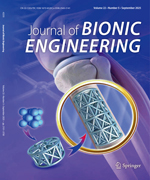|
|
Bio-inspired Graphene-enhanced Thermally Conductive Elastic Silicone Rubber as Drag Reduction Material#br#
Limei Tian1, E Jin1, Haoran Mei2, Qingpeng Ke1, Ziyuan Li1, Hailin Kui3
Journal of Bionic Engineering. 2017, 14 (1):
130-140.
DOI: 10.1016/S1672-6529(16)60384-0
This study presented a graphene platelet/silicone rubber (GPL/SR) composite as a drag reduction material, inspired by the boundary heating drag reduction mechanism of dolphin skin. Graphene was added as a thermally conductive filler at weight fractions of 0.17 wt%, 0.33 wt% and 0.67 wt% to pristine silicone rubber (PSR). Tests of the thermal conductivity and tensile properties showed that the thermal conductivity of all three GPL/SR materials of 0.17 wt%, 0.33 wt% and 0.67 wt% graphene were 20%, 40% and 50% higher than that of the PSR, respectively, and the elastic modulus of the 0.17 wt% GPL/SR materials was lowest. Droplet velocity testing, which can reflect the drag reduction mechanism of the heating boundary controlled by the GPL/SR composite, was performed between 0.33 wt% GPL/SR, which typically exhibits good mechanical properties and thermal conductivity performance, and the PSR. The results showed that on the 0.33 wt% GPL/SR, the droplet velocity was higher and the rolling angle was lower, implying that the GPL/SR composite had a drag-reducing function. In terms of the drag reduction mechanism, the heat conductivity performance of the GPL/SR accelerated the heat transfer between the GPL/SR composite surface and the droplet. The forces between the molecules decreased and the droplet dynamic viscosity was reduced. The drag of a sliding water droplet was proportional to the dynamic viscosity, which resulted in drag reduction. The application of GPL/SR material to the control fluid medium should have important value for fluid machinery.
Related Articles |
Metrics
|

 Table of Content
Table of Content
 Table of Content
Table of Content